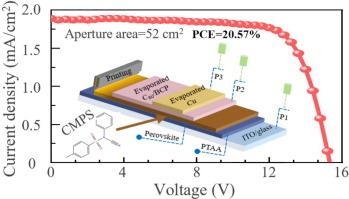Additive engineering for colloid stabilization and crystallization control in slot-die coated large-area solar modules
IF 14.9
1区 化学
Q1 Energy
引用次数: 0
Abstract
Scalable fabrication of homogeneous perovskite films remains crucial for bridging the efficiency gap between lab-scale solar cells and commercial solar modules. To tackle this issue, we introduce N-Cyano-4-methyl-N-phenylbenzenesulfonamide (CMPS) additives into perovskite precursors, enabling slot-die coating of large-area modules under ambient conditions. CMPS suppresses colloidal aggregation and delays crystallization, yielding high-quality uniform films. Small-area devices (0.07 cm2 aperture area) incorporating CMPS exhibited a significant efficiency increase from 22.07 % to 24.58 %. Corresponding encapsulated devices maintained 85 % of their initial power conversion efficiency (PCE, average 23.56 %) after 1500 h of continuous maximum power point (MPP) tracking under one-sun illumination at 50–55 °C. Furthermore, we demonstrate impressive efficiency of perovskite solar modules, achieving 20.57 % (52 cm2 aperture area) for 10 cm × 10 cm mini-modules and 17.02 % (260 cm2 aperture area) for 21 cm × 21 cm sub-modules, representing the state-of-the-art performance for solution-processed devices at these scales.

槽模涂覆大面积太阳能组件胶体稳定与结晶控制的增材工程
均质钙钛矿薄膜的可扩展制造对于弥合实验室规模的太阳能电池和商业太阳能组件之间的效率差距至关重要。为了解决这个问题,我们在钙钛矿前驱体中引入了n -氰-4-甲基- n -苯基苯磺酸酰胺(CMPS)添加剂,实现了在环境条件下大面积模块的槽模涂层。CMPS抑制胶体聚集和延迟结晶,产生高质量的均匀薄膜。采用CMPS的小面积器件(孔径面积为0.07 cm2)的效率从22.07%提高到24.58%。在50-55°C的单太阳照射下,经过1500小时连续最大功率点(MPP)跟踪后,相应的封装器件保持了85%的初始功率转换效率(PCE,平均23.56%)。此外,我们还展示了钙钛矿太阳能组件令人印象深刻的效率,10厘米× 10厘米微型组件的效率达到20.57%(52平方厘米孔径面积),21厘米× 21厘米子模块的效率达到17.02%(260平方厘米孔径面积),代表了这些规模下溶液处理设备的最先进性能。
本文章由计算机程序翻译,如有差异,请以英文原文为准。
求助全文
约1分钟内获得全文
求助全文
来源期刊

Journal of Energy Chemistry
CHEMISTRY, APPLIED-CHEMISTRY, PHYSICAL
CiteScore
19.10
自引率
8.40%
发文量
3631
审稿时长
15 days
期刊介绍:
The Journal of Energy Chemistry, the official publication of Science Press and the Dalian Institute of Chemical Physics, Chinese Academy of Sciences, serves as a platform for reporting creative research and innovative applications in energy chemistry. It mainly reports on creative researches and innovative applications of chemical conversions of fossil energy, carbon dioxide, electrochemical energy and hydrogen energy, as well as the conversions of biomass and solar energy related with chemical issues to promote academic exchanges in the field of energy chemistry and to accelerate the exploration, research and development of energy science and technologies.
This journal focuses on original research papers covering various topics within energy chemistry worldwide, including:
Optimized utilization of fossil energy
Hydrogen energy
Conversion and storage of electrochemical energy
Capture, storage, and chemical conversion of carbon dioxide
Materials and nanotechnologies for energy conversion and storage
Chemistry in biomass conversion
Chemistry in the utilization of solar energy
 求助内容:
求助内容: 应助结果提醒方式:
应助结果提醒方式:


